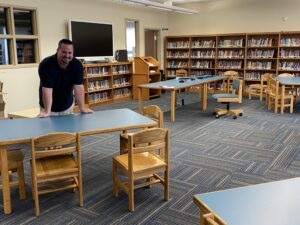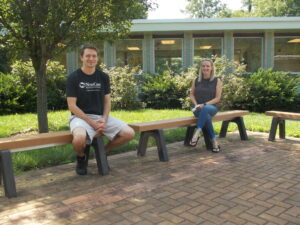
Students have begun returning to schools in the Diocese of Wilmington, but the 2020-21 academic year is not like any other that has preceded it. There is tape on floors, desks placed six feet apart, and hand sanitizer galore, all part of the battle to keep students, faculty and staff safe against coronavirus.
Schools closed in March after the coronavirus outbreak. They did not reopen. A few weeks ago, the Catholic Schools Office released its plan to reopen schools. In the diocese, the ones with fewer than 250 students are allowed to offer in-person learning to all of its children, while those above that threshold are offering a hybrid option, at least for the first six weeks of the year. The youngest students, from pre-kindergarten through first grade, will have in-person instruction full-time. The schools were able to design their own return-to-campus plans. A sampling from around the diocese follows.

At St. Elizabeth School, the lower and upper schools share a building, but they operate separately. Terre Taylor, the principal of the upper school (grades 7-12) said the older students will be using a hybrid model, while their younger counterparts will be there full-time.
The seventh- through 12th-graders are assigned to either the maroon or gold group. “Each group will have two days of in-the-building, in-person instruction, two days of independent, at-home instruction, and one day of at home Zoom classes,” Taylor said.
No in-person instruction will occur on Wednesdays, but students will be able to go in for standardized tests, for example. The building will be cleaned twice a day while the students are there, and also on Wednesdays.
The assignment of students to a group was random, but adjustments were made so family members were in the same color. Administrators also made sure no classes were overloaded.
“We’re taking a lot of unnecessary items out of classrooms to make use of all available space,” Taylor said.
She said feelings were split between those excited to get back into the building and those who would rather stay home. Taylor is also a mother of middle-school twins, so she understands the sentiment.
“As every parent would have, we have concerns, but I’m confident that the proper safety measures are in place. I’m comfortable with it,” she said.
All students will be attending St. Edmond’s Academy, although they have the option to remain home, lower form principal Julianna McClellan said. The school will make use of its large campus as long as the weather is nice.
“We are planning to our outside classrooms,” she said. “We bought some new materials. Each kid’s going to have his own seat that he goes outside with. We’ve put beach towels on our supply list so we can eat lunch outside. Hopefully, the weather cooperates for a while and we can really use the spacing outside.”

Each form — lower is the younger grades, upper is the older — remain at opposite ends of the building. Teachers will rotate classrooms in order to cut down on unnecessary interaction between students. High-traffic areas will be cleaned regularly.
Webcams have been installed in every classroom for those students who choose to remain at home, although that number is extremely low. St. Edmond’s met with faculty and parents this summer to outline its safety measures. They have asked for patience as everyone navigates the new normal together.
“It’s not an easy time, but if we all work together, I think it can be a successful year,” McClellan said.
St. Edmond’s will have an extra week to get everything ready. A flood during a storm in early August necessitated some repairs, pushing opening day back.
St. Mary Magdalen School is too large to have everyone attend at the same time, but principal Patrick Tiernan is confident that all of the students will receive a quality education whether in the building or at home. Students have been divided into two groups and will attend for a week, then remain home the next week.
“The rationale behind the week setup is to mitigate the interactions with the faculty and students,” Tiernan said.
While at home, students will have projects to keep them busy. The school has invested in new laptops for the faculty so they can record lessons, but the plan is to be more asynchronous. They could have the students at home watch the live classes, “but in terms of pedagogy, that’s not the best way for them to learn. They shouldn’t be in front of a screen for six hours,” he said. “It’s not a panacea for teaching. Is it an option for having a classroom discussion? Sure. But in terms of being a proverbial baby sitter, that’s not the approach.”
Teachers also will have virtual office hours, and St. Mary Magdalen will have a virtual homework club for youngsters who need that support. The school will collect feedback over the first six weeks to determine what’s working and what needs improvement, and they are ready to go all-remote or all in-person.
Physical improvements to the building include new ionizers to help with air circulation and freshening. Picnic tables have been added outside, and tents will be set up.
Holy Cross School has more than 250 students, but all of them will be on campus when classes resume unless they opt for at-home instruction. The Dover campus has three buildings used for classes, and none of the structures will house more than 250 children, said principal Linda Pollitt.

“Each school is a unique community,” she said. “So you have to adapt that plan to your school and change it to fit. And that’s what we’ve done.”
Some families are nervous about returning to in-person learning, but they are the minority,” she added. “The very first response I got after I released the plan was from a family, and his response was simply, ‘Praise Jesus.’ That pretty much reflects the response.”
Pollitt believes the risk of anyone contracting coronavirus is minimal. Holy Cross has gotten interest from local public school families, and she has given several tours over the summer. Aftercare will be open with a capacity of 85 children in two groups, one in the cafeteria, the other in the gymnasium. Like the other schools, they will take advantage of nice weather by holding classes and possibly lunches outside.
“There are many, many things we can do.”
The largest elementary school in the diocese, Christ the Teacher, has divided its students from second through eighth grade into two groups. Each will report to school every other day, five days every two weeks. On the days they are at home, students will have enrichment and other projects. No classes will be taught online, principal Stephen Adams said.
The most important tool in the building during the summer months was a yardstick, he joked. Masks will be required for all students and faculty as they enter and exit the building. In accordance with new state guidelines, kindergarten and older will keep them on during the day. The playground will be open and disinfected after each use. Teachers will be encouraged to go outside as much as possible.
“I feel much more comfortable with the governor’s and the diocese’s recommendations to go hybrid. It allows us to possibly mitigate the illness as much as we possibly can,” he said.
Reaction to Christ the Teacher’s hybrid plan has been positive. Parents shared their desires and concerns over the past few months, and Adams and his team worked to implement as much as they could safely.

In Childs, Md., Mount Aviat Academy recently hosted tours for families to highlight the measures now in place to keep everyone healthy. Hand sanitizer greets visitors, who can go upstairs using one stairwell and down using another. The library has been converted into a classroom, and other adjustments have been made so that students can return.
Niles Ugarte, an eighth-grader, visited with his father Jomar. Niles said he kind of liked being at home, but he doesn’t expect much difficulty going back to in-person instruction.
“It won’t be that much of a transition,” he said.
His father is comfortable with him returning and said it’s time for his son to get out of the house. Jomar Ugarte remembered how close together the desks were at Mount Aviat, but that is no longer the case.
“I think the school’s plan is good, the spacing out and distancing. I think it’s good for (Niles), too, because since this started, he’s been at home,” he said.
Teresa and Steve Watkins toured the school with their sons, Mason, who will be in kindergarten, and Owen. Teresa Watkins said they have “no issues” with sending Mason back.
They have absolutely done wonderful things to make sure our kids are safe,” she said.
Mason is excited about seeing his friends again, and his mother thinks that environment is better for his development. “He learns better, more focused at school. I think it’s what’s best for him.”
Archmere Academy is offering a hybrid model for its students, said principal Katie Eissler Thiel. Those who are ill or not comfortable returning “can tune in via the classroom cameras that we’ve invested in,” she said. “So far, the large majority of students are planning to come back. We’ve only heard from a handful who are opting for the virtual.”
The school can accommodate all of its students and meet safety guidelines, she added. Class rosters have been modified, and nearly all classes will have no more than 10 students. Teachers essentially will be teaching two sections of each class.
“We’re supplementing our in-person classes with asynchronous content. Lessons that students will be able to access during free periods, at home, on the weekends, all that good stuff,” she said.
Finally, St. Anthony of Padua School in Wilmington will be welcoming all of its students back for in-person instruction, principal Judy White said. Parents can choose remote learning, and their children will not miss out on anything thanks to the technology the school has invested in the past few years. As of mid-August, about 70 percent of students were scheduled to return to the building, White said.
St. Anthony’s and other Catholic schools experienced increased interest as the summer went on as local public districts opted for virtual learning.
“Parents need to go back to work,” White said. “Many are first responders and teachers. I’m just feeling blessed we can do this.”






